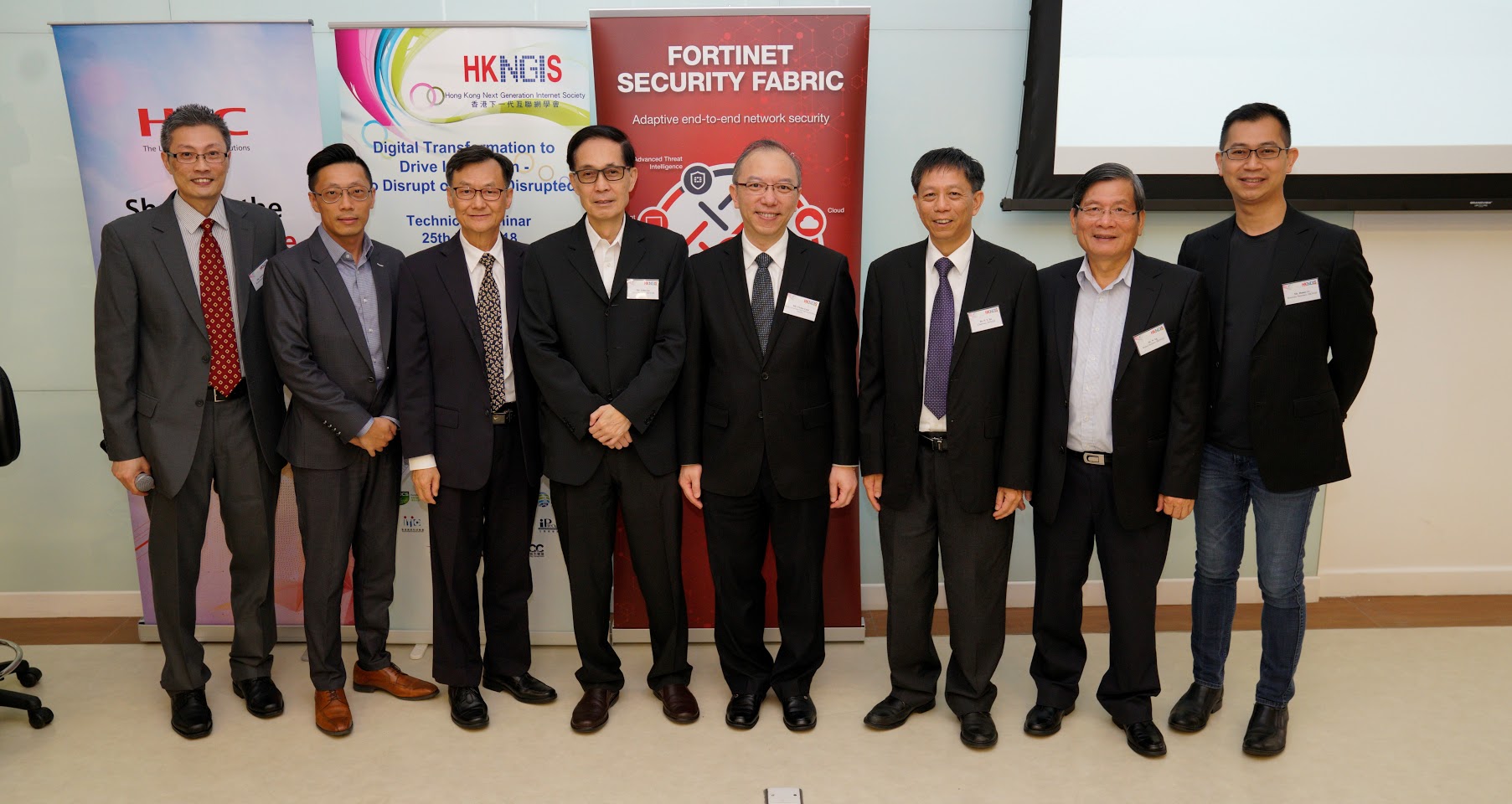Opening Speech by Mr. Victor Lam, JP, Deputy Government Chief Information Officer, at the Technical Seminar “Digital Transformation to Drive Innovation – To Disrupt or To be Disrupted” (with photo)
Dr CANNON (Dr Steven J CANNON, Executive Vice-President (Administration & Finance), The University of Hong Kong), Dr HO (Dr PT HO, Chairman, Hong Kong Next Generation Internet Society), Mr CHU (Mr Carlson CHU, Board Director, Hong Kong Next Generation Internet Society), distinguished guests, ladies and gentlemen,
Good afternoon! I am delighted to join you at this seminar co-organised by the Hong Kong Next Generation Internet Society and the Information Technology Services of The University of Hong Kong on this very essential topic of digital transformation.
The rapid advancement of new technologies like cloud computing, big data analytics, Internet of Things (IoT) and Artificial Intelligence (AI) have given birth to innovative business models and new entrants. They have threatened the market incumbents and disrupted the traditional industry players. Many companies have adopted digital technologies and fundamentally transformed multiple aspects of their businesses to meet the rising demand of customers and the public as well as the keen competitions from their peers.
We have witnessed many such examples of digital transformation in sectors such as banking, retail, catering, media and entertainment.
A recent study by the International Data Corporation (IDC) predicts that there will be a dramatic acceleration in the pace of digital transformation across Asia-Pacific economies. As for Hong Kong, according to IDC’s study, about 5% of our GDP was derived from digital products and services created directly from the use of digital technologies, such as mobility, cloud, IoT, and AI in 2017, and it is expected to surge to 60% by 2021. It is obvious that digital transformation is gaining steam. Both the private and public sectors will certainly continue to invest in technology, creating value for their own service offerings.
Over the years, the Government has been adopting digital technology to transform the delivery of public services. One way to leverage new technologies to drive innovation is to make use of data generated in our day-to-day operations. Therefore, the Government has launched the Open Data Portal, data.gov.hk, to disseminate open data contributed by government departments as well as public and private organisations.
Over 3 200 unique datasets grouped under 18 categories covering areas such as climate and weather, transport, finance, population, etc. are available on this portal. By making use of the open data, we wish to tap community wisdom to create innovative solutions and transformative services. Over 70 mobile apps have been developed by the industry. For example, some of these apps have used traffic snapshot images to provide real-time traffic conditions that enable drivers to plan their routes.
In the area of healthcare, the territory-wide patient-oriented Electronic Health Record Sharing System rolled out in 2016 is another example of digital transformation. The system enables medical professionals in both the public and private sectors to share patient records for timely and accurate patient care. It offers an unprecedented realm of healthcare collaboration benefitting patients, clinicians and the society as a whole.
Other public bodies like the Hong Kong Airport Authority has deployed a range of new technologies, from augmented reality to IoT and iBeacon, to help monitor and analyse passenger numbers, luggage handling and retail traffic in order to provide a pleasant travel experience for its passengers. In addition, you may have noticed that MTR has recently introduced a chatbot function to its mobile app which provides information of suggested routes and estimated journey time for its commuters.
We are also working on the further development of Hong Kong into a smart city. Riding on innovation and technologies, the Government is committed to developing Hong Kong into a world-class smart city to improve people’s quality of living, enhance city management and address urban challenges.
Last December, the Government released the Smart City Blueprint for Hong Kong that maps out the plans to realise our smart city vision. Two weeks ago, the Legislative Council’s Finance Committee approved $645 million funding for the implementation of two key infrastructure projects for smart city development.
We will provide an electronic identity (eID) free to all Hong Kong residents by mid-2020. The eID will serve as a common key for digital identity authentication to log in and access government and commercial e-services, such as licence renewal, booking of venues or online banking, in a simple, convenient and secure manner.
The eID will also support digital signing with legal backing under the Electronic Transactions Ordinance (Cap. 553) for handling contracts, statutory documents and procedures, important commercial transactions, etc. In short, the eID will foster the development of a new economic service model that emphasises direct interface with citizens and consumers.
To make best use of new technologies, we will also modernise the government cloud infrastructures and build the next generation GovCloud and a big data analytics platform. Through resources sharing, we aim to facilitate the implementation of more big data analytics projects, for example on weather, transport, environment, etc. with the adoption of big data analytics and AI technologies. Coupled with the pilot smart lamppost project in the pipeline, cloud computing and big data will help enhance the operational efficiency of the Government, and at the same time, offer opportunities for us to innovate and further improve our public services.
Smart city development is a digital transformation journey. The Government has embarked on this journey and is determined to accomplish our goals together with the industry, the academia and our citizens. For the private sector, digital transformation is also a very relevant direction. It provides the competitive edge for companies’ progression in this highly competitive business environment.
On this note, I would like to conclude my speech. I am sure that distinguished speakers will share with us their valuable experience and insights on their own digital transformation journey. Thank you.
- ENDS -




